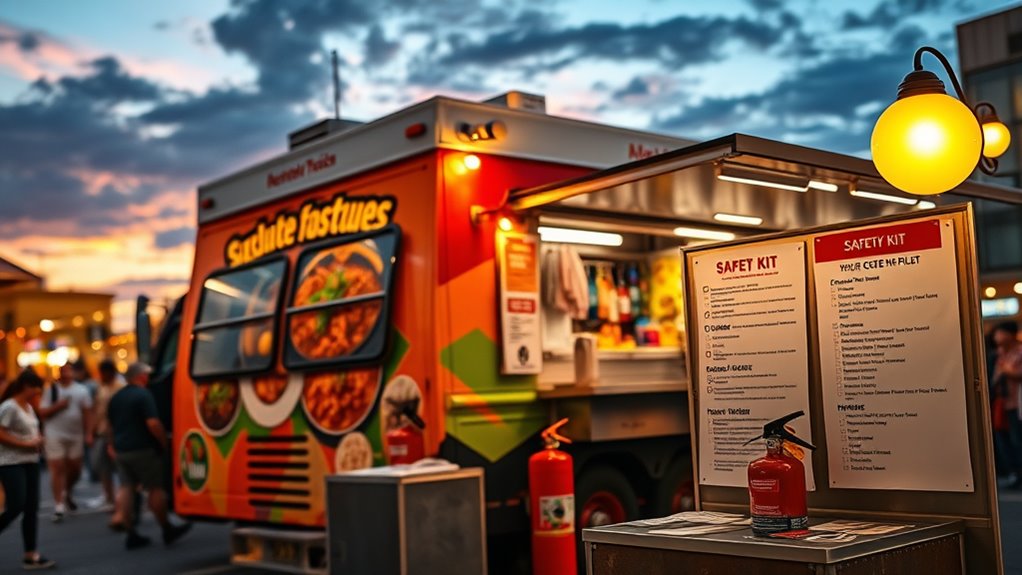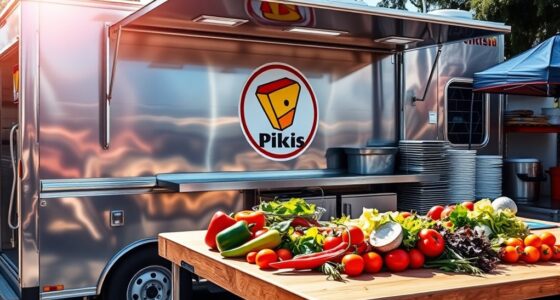To guarantee your food truck’s power system runs safely and efficiently, start by evaluating your appliances’ wattage and usage to plan your power needs. Choose reliable, portable generators that match your load and consider backup options like batteries for emergencies. Follow electrical safety codes, perform regular inspections, and maintain your equipment to prevent hazards. Keep safety top of mind, and explore detailed steps to power up confidently as you continue with your setup process.
Key Takeaways
- Conduct a comprehensive power needs assessment by listing appliances, wattage, and usage to ensure proper generator sizing.
- Choose reliable, properly rated generators and implement power management systems to prevent overloads and ensure safety.
- Ensure electrical wiring complies with local codes, use weatherproof equipment, and install safety devices like smoke detectors.
- Develop backup power plans with portable generators or battery systems, considering noise, runtime, and safety guidelines.
- Schedule regular maintenance and inspections of electrical and generator systems to prevent hazards and ensure consistent, safe power supply.
Assessing Power Needs for Your Food Truck
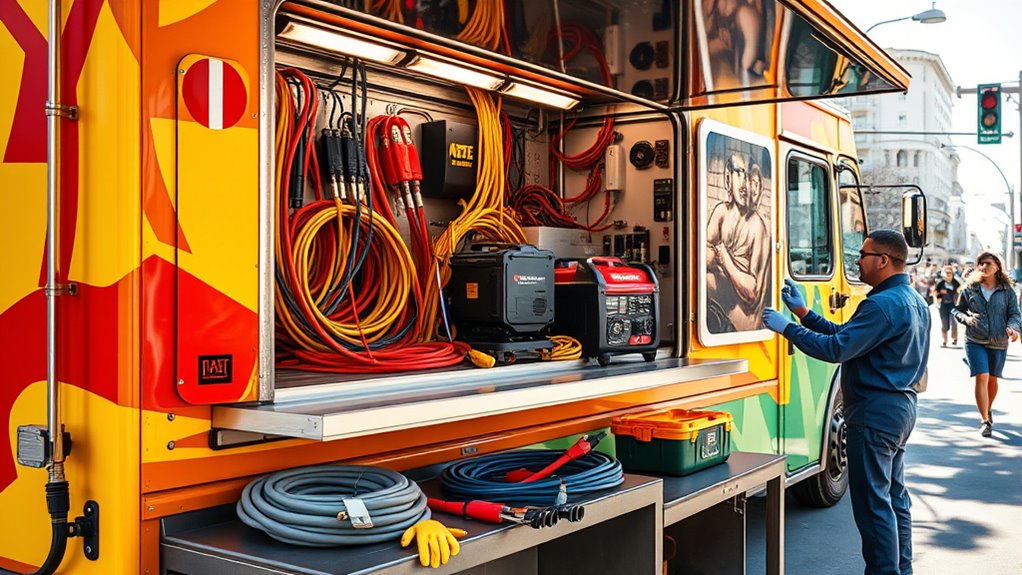
Before you can choose the right power setup for your food truck, you need to accurately assess your energy requirements. Start with a thorough power consumption analysis to determine how much electricity your equipment needs during operation. List all appliances, including refrigeration, cooking devices, and lighting, then note their wattage and estimated usage times. This helps you identify your total power load. Don’t forget to take into account future expansion or additional equipment. Once you know your power needs, regularly check your generator maintenance schedule to ensure reliable operation. Proper generator maintenance prevents unexpected breakdowns and keeps your power consistent. Additionally, understanding your energy demands and maintaining your generator properly will help you make informed decisions about your power system. By understanding your energy demands and maintaining your generator properly, you’ll be better prepared to select the right power system that keeps your food truck running smoothly.
Choosing the Right Power Sources and Equipment

Selecting the appropriate power sources and equipment is essential to guarantee your food truck runs efficiently and safely. You want options that maximize fuel efficiency while providing reliable power. Portable generators are a popular choice because they’re versatile and easy to move around. When choosing a generator, consider its wattage capacity to meet your equipment needs without overloading. Look for models with fuel-efficient engines to keep running costs low and reduce emissions. Additionally, explore alternative power sources like batteries or hybrid systems if your setup allows, as they can offer quieter and cleaner operation. Prioritize equipment that matches your power demands and fits within your truck’s space constraints. Using a power management system can help optimize energy use and prevent overloads, ensuring smooth operations, minimizes downtime, and keeps your staff safe and productive.
Implementing Safety Measures and Electrical Codes
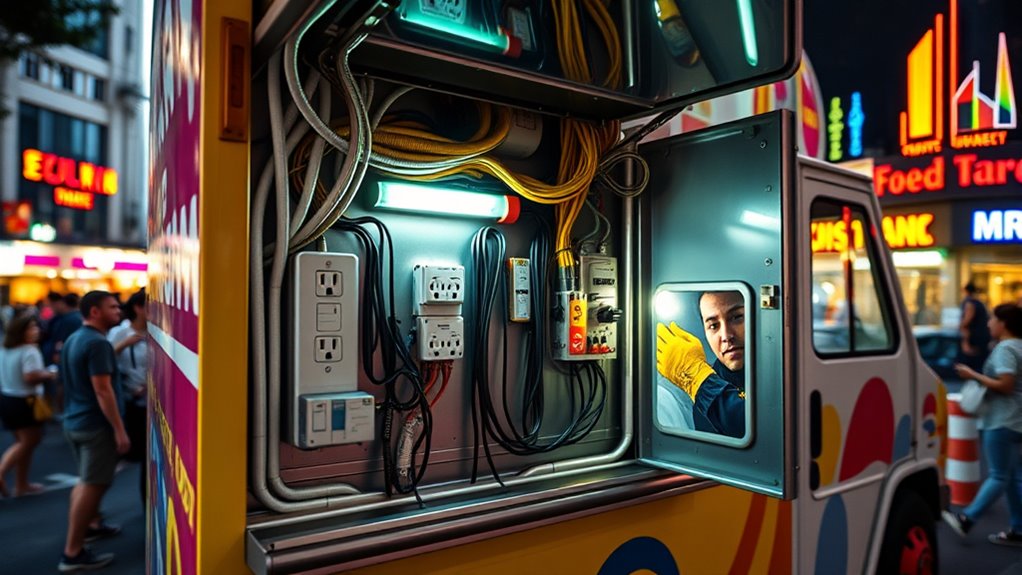
To guarantee your food truck operates safely and complies with electrical standards, you must implement proper safety measures and adhere to relevant electrical codes. Start by ensuring all wiring and electrical systems meet local regulations to prevent hazards. Prioritize fire safety by installing fire extinguishers and smoke detectors, and regularly inspect electrical components for damage or wear. Staff training is essential—teach your team how to recognize electrical issues, handle equipment safely, and respond to emergencies. Clearly label circuit breakers and keep electrical panels accessible. Use weatherproof and certified equipment to reduce risks. Additionally, understanding the power consumption of your equipment can help manage energy use effectively. By following these safety protocols and electrical codes, you protect your staff, customers, and your investment, creating a safer work environment and ensuring smooth, compliant operations.
Planning for Emergency Power and Backup Solutions
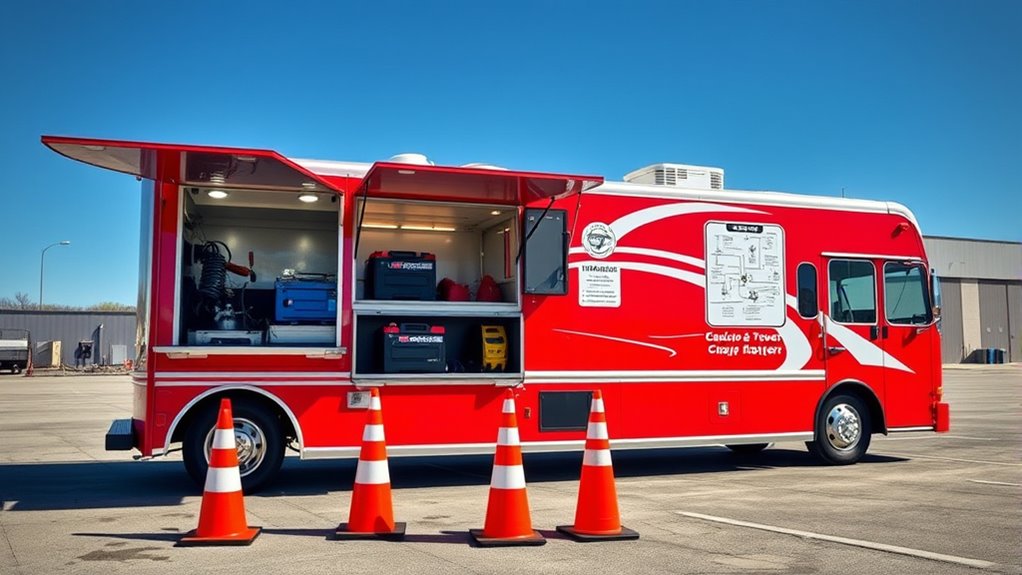
Planning for emergency power and backup solutions is vital to keep your food truck operational during outages or technical failures. Having a reliable backup system guarantees you stay open and serve customers without interruption. A portable generator is a common choice, but safety is essential—always follow generator safety guidelines to prevent accidents and carbon monoxide risks. Prepare for power outages by having a clear plan that includes backup power sources, fuel storage, and quick setup procedures. Use the table below to compare key backup options:
| Backup Solution | Pros | Cons |
|---|---|---|
| Portable Generator | Flexible, easy to use | Noise, fuel dependency |
| Battery Power Systems | Quiet, low maintenance | Limited runtime |
| Inverter Systems | Efficient for small loads | Not suitable for heavy use |
Additionally, understanding the side effects of juice detox can help you make informed health choices when considering dietary changes.
Maintenance and Inspection for Safe Power Operation

Have you ever considered how regular maintenance and inspections can prevent power failures and safety hazards? Consistent generator maintenance keeps your equipment running smoothly and reduces the risk of unexpected breakdowns. Schedule routine electrical inspections to identify potential issues early, such as faulty wiring or worn-out components. During these inspections, check for loose connections, corrosion, and overheating signs. Ensure filters are clean and fuel levels are adequate. Properly maintaining your generator and conducting thorough inspections enhances safety and prolongs equipment lifespan. Neglecting these steps can lead to power outages, electrical fires, or equipment damage. Make maintenance a priority, and always follow manufacturer guidelines to keep your food truck powered safely and efficiently. Additionally, referencing best anime movies can provide a relaxing way to unwind after a busy maintenance day.
Frequently Asked Questions
How Can I Calculate My Food Truck’s Total Power Consumption Accurately?
To accurately calculate your food truck’s total power consumption, start with a power consumption estimation for each appliance. Then, perform an electrical load calculation by adding up these individual estimates to find the overall load. This helps you determine your power needs, ensuring your generator or electrical system can handle everything safely and efficiently. Always include some extra capacity for unforeseen power demands or future upgrades.
What Are the Most Common Electrical Hazards in Food Trucks?
You should watch out for fire hazards and electrical shocks, the most common electrical hazards in food trucks. Overloaded circuits and faulty wiring can spark fires, so avoid plugging too many devices into one outlet. Always inspect wiring for damage and make certain all connections are secure. Use proper grounding and circuit breakers to prevent electrical shocks. Regular maintenance and safety checks help keep your food truck safe and compliant.
How Often Should Electrical Systems Be Inspected and Maintained?
Think of your food truck’s electrical system as the heartbeat of your operation; it needs regular check-ups to keep running smoothly. You should inspect and maintain your electrical systems at least every 6 to 12 months, especially after electrical upgrades or when installing power backups. Regular inspections help identify potential hazards early, ensuring safety and compliance. Stay proactive—your livelihood depends on it.
What Permits Are Required for Installing Electrical Equipment on a Food Truck?
You need to obtain electrical permits before installing any electrical equipment on your food truck. These permits ensure your installation meets local safety and code requirements. Check with your city or county’s building department for specific installation requirements, which often include proper wiring, grounding, and safety measures. Failing to secure the necessary electrical permits can lead to fines, delays, or safety hazards, so always verify and adhere to local regulations.
How Do I Train Staff on Electrical Safety Procedures?
You should train your staff on electrical safety by conducting hands-on sessions and clear demonstrations of proper procedures. Emphasize fire safety and emergency protocols, such as knowing how to shut off power quickly and using fire extinguishers. Reinforce the importance of avoiding damaged cords and staying aware of potential electrical hazards. Regularly review safety procedures and encourage questions to guarantee everyone understands how to stay safe during operations.
Conclusion
Now that you know the essentials for powering your food truck safely, the real challenge begins. Will your chosen systems hold up under pressure? Are your safety measures enough to prevent surprises? As you put your plan into action, remember—staying prepared means staying ahead. Keep your equipment inspected, your backup ready, and your safety protocols sharp. The road to a successful, worry-free food truck operation starts here—are you ready to take the next step?
